Depopulation and repopulation (De-pop / re-pop)
De-pop/re-pop is a control measure which consists of emptying the farm (depending on the disease, the pigs will be sent to slaughter or will be euthanized and incinerated); once the farm is empty, it is cleaned and disinfected and finally, new animals (free of the disease) are introduced into the farm. De-pop / re-pop is a costly control method and requires thorough planning. To make it worthwhile, it must be followed by:
- good biosecurity measures and farm hygiene, such as:
- asking visitors to be pig free, (not visited other farms for at least 2 days before they visit your farm)
- strict cleaning and disinfection of trucks and pens before a new lot of pigs is introduced,
- pens should be filled and emptied on an all-in all-out basis,
- avoid mixing piglets from separate litters, and especially from separate farrowing rooms
- partitions between pens have to be solid-sided in order avoid pig contact,
- do not buy sows or boars from infected (in the case of PRRS) or
highly / medium affected farms (in the case if PMWS),
- training the staff to follow the new biosecurity and farm hygiene policies
In some farms de-pop / re-pop might not be an optimal / realistic option, and an evaluation of the situation including logistics and cost of alternative improvements in farm hygiene and biosecurity practices should be considered. In the initial assessment, potential improvements in production should be considered (for example mortality reduction, improvement in feed conversion ratio, production time reduction). This evaluation, which in fact is a partial budget analysis, should be done between the vet and the farmer and every farm unit should be assessed individually. The diagram and the links to the cost-calculator and potential improvements in production given below can be used as a guide to evaluate whether de-pop / re-pop is worth considering for your farm; it does not however, provide a model which can be applied direct to your situation. This would need to be discussed between you and your vet consultant.
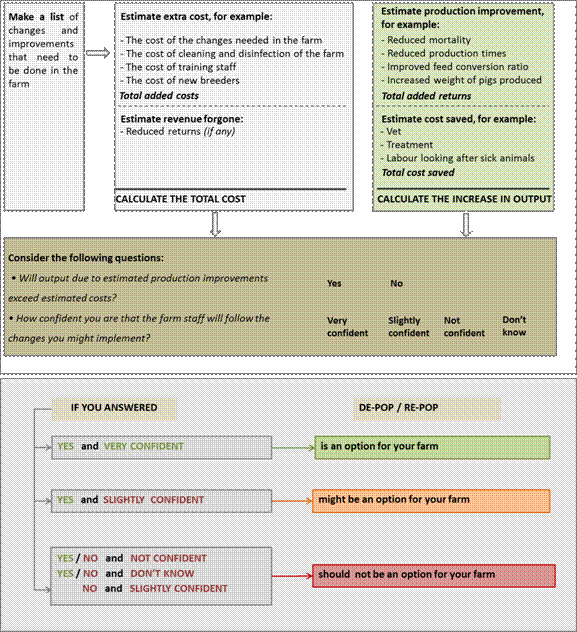

http://dl.dropbox.com/u/40029445/PRRS_PMWS/Estimated%20costs.xlsx
http://dl.dropbox.com/u/40029445/PRRS_PMWS/Estimated%20production_improvement.xlsx
If it is decided that de-pop /re-pop is an option for the farm, in the case of PRRS, the new sows have to come from a PRRS virus free herd when re-populating the farm. In the case of PMWS the aim of this strategy is to reduce other pathogens. It is unrealistic to find herds that are completely free of PCV-2, but sows should come from a herd that has not showing clinical signs (high health herds).
When would be the best time to carry out de-pop / re-pop?
Pig prices follow a cycle. Typically, when prices are high more people start producing pigs, however there is a delay in supply of finished pigs due to the breeding time plus fattening period. After a time, there is an excess of finished pigs (i.e. the market is saturated), and so prices drop. The figure below illustrates these cyclical fluctuations in finishing pigs prices in three European countries.
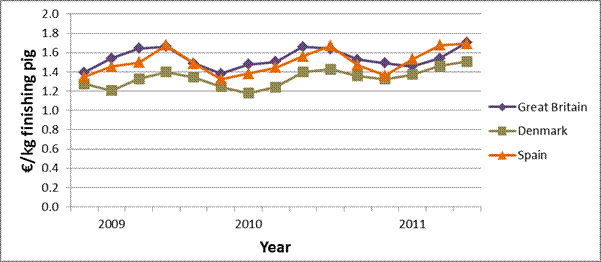
Adapted from: www.themeatsite.com
How does this impact on the best time to depopulate a herd?
If it is decided that de-pop /re-pop is a good option for a herd, there might be financial benefits from selecting the best stage of the cycle to start depopulating. Take for example a farrow-to finish farm X where the change in the gross margin over time is as follows:
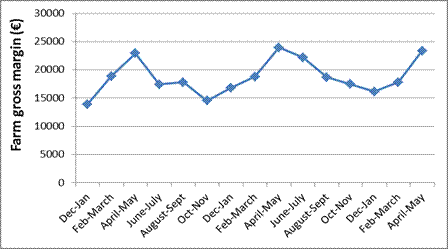

In this particular farm, gross margin is always higher in April-May, and this can be taken in your favour when considering de-pop / re-pop. The following outlines three alternative strategies.
Strategy 1 De-pop all at once
The best time to send all the animals to slaughter would be while prices are still high but just before prices start to drop (illustrated in graph below), so animals are sold at the best possible price. Now, if we consider that the farm will not be selling any further pigs for a year following the de-pop, due to time for disinfection and breeding time, the farm will resume selling finished pigs when prices are picking up again.
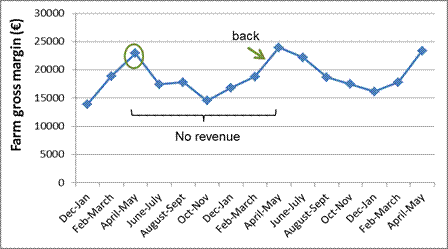



At the other extreme, the worst option would be to sell animals when prices are at the bottom of the cycle and to re-start selling when prices are low again (illustrated in graph below).
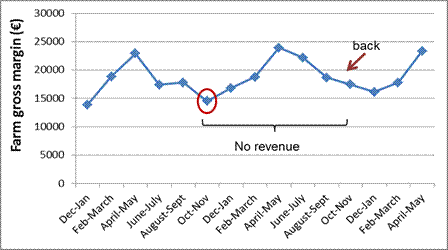

Strategy 2 De-pop / re-pop: Scaling down
Alternatively depopulation can be done in phases. For example, sending sows to slaughter after weaning the piglets and waiting until the pigs are ready to slaughter (20 to 24 weeks afterwards) before the whole farm is depopulated. If we take as an example farms that sell finished pigs every 3 weeks it would take between 38 to 42 weeks (8.5-9.5 months) to de-populate the whole farm. Alternatively, in order to shorten this time, when piglets from the last lot of sows are weaned they could be sold as weaner pigs instead of waiting until they are finished; this way it would take 18 weeks (around 4 months) to de-populate the farm. However, be aware that it might be difficult to find a buyer for the weaners given that they come from an infected farm.
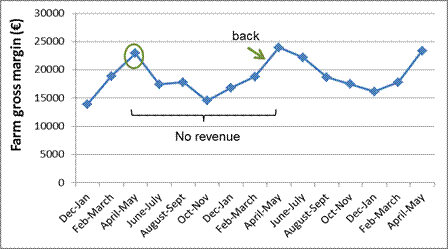

Strategy 3 Partial de-pop /re-pop
In the case of a multi-site farm, where the different sites are clearly divided, an alternative option would be partially de-pop / re-pop the enterprise. For example, this might be considered when there has been a PRRS outbreak in a finishing herd but the separate breeding units are not affected. One of the above models could be used to decide when to depopulate the finishing unit.
As mentioned before, decisions should be made based on the farm situation and what could be the best option for one farm might not be best for neighbouring farms or other farms in the same business.